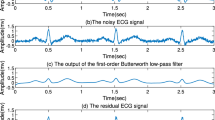Abstract
A method has been developed for removing the P-wave from the electrocardiogram to facilitate the study of the electrical activity in the atrio-ventricular conduction system and in particular of the activity in the bundle of His. When the PQ-segment in the electrocardiogram of a subject at rest is subtracted from the PQ-segment of the same subject shortly after exercise stress, the resulting signal will, because of the changed PQ-time, be a distored P-wave. Reconstruction of the P-wave can then be accomplished with the help of a special algorithm after which the reconstructed P-wave can be subtracted from the e.c.g.
Similar content being viewed by others
References
Berbari, E. J., Lazzara, R., El-Sherif, N. andScherlag, B. J. (1975) Extracardiac recordings of His-Purkinje activity during conduction disorders and junctional rhythms.Circulation,51, 802–810.
Berbari, E. J., Lazzara, R., Scherlag, B. J. (1979) The effects of filtering the His-Purkinje system electrogram.IEEE Trans.,BME-26, 82–85.
Bouman, L. N. (1965) The action of the vagal nerves on the pacemaker activity of the sino-auricular node. Thesis.
Bouman, N. H., Mackaay, A. J. C., Bleeker, W. K. andBecker, A. E. (1978) Pacemaker shift in the sinus node: effects of vagal stimulation, temperature and reduction of extracellular calcium.The Sinus Node, Martinus Nijhof Med. Div., The Hague.
Brody, D. A., Woolsey, M. D. andArzbaecher, R. C. (1967) Application of computer techniques to the detection and analysis of spontaneousP-wave variations.Circulation,36, 359–371.
Clynes, M. E. (1960) Respiratory heart rate reflex (RHR) in man: mathematical law.Medical Physics, III, The Year Book Pbl., Illinois.
Damato, A. N., Lau, S. H., Berkowitz, W. D., Rosen, K. M. andLisi, K. R. (1969) Recording of specialized conduction fibers (A-V nodal, His bundle, and right bundle branche) in man using an electrode catheter technique.Circulation,39, 435–447.
Flowers, N. C., Hand, R. C., Orander, P. C., Miller, C. B. andWalden, M. O. (1974) Surface recording of electrical activity from the region of the bundle of His.Am. J. Cardiology,33, 384–398.
Furness, A., Sharrett, G. P. andCarson, P. (1975) The feasibility of detecting His-bundle activity from the body surface.Cardiovascular R.,9, 390–396.
Hamilton, W. F. (1962)Handbook of Physiology II. Am. Phys. Soc., Washington.
Hishimoto, Y. andSawayama, T. (1975) Non-invasive recording of His bundle potentials in man.Br. Heart J.,37, 635–639.
Irishawa, H. andSeyama, I. (1966) The configuration of theP-wave during mild exercise.Am. Heart J.,71, 467–472.
Janse, M. J., Capelle van F. J. L., Anderson, R. H., Touboul, P. andBillette, J. (1976) Electrophysiology and structure of the atrioventricular node of the isolated rabbit heart.The conduction system of the heart, Stenfert Kroese, Leiden.
Jury, E. I. (1973)Theory and application of the z-transform method. R. E. Krieger Publ. Co., Huntington, New York.
Steinbeck, G., Bonke, F. I. M., Allessie, M. A. andLammers, W. J. E. P. (1978) Cardiac glycosides and pacemaker activity of the sinus node: a micro electrode study on the isolated right atrium of the rabbit.The Sinus Node, Martinus Nijof Med. Div., The Hague.
Tekada, H., Kitamura, K., Takanashi, T., Tokuoka, T., Hamamoto, H., Katoh, T., Niki, I. andHishimoto, Y. (1979) Noninvasive recording of His-Purkinje activity in patients with complete atrioventricular block.Circulation,60, 421–426.
Vincent, R., Stroud, N. P., Jenner, R., English, M. J., Woolons, D. J. andChamberlain, D. A. (1978) Noninvasive recording of electrical activity in the PR segment in man.Br. Heart. J.,40, 124–130.
Wajszczuk, W. J., Stopczyk, M. J., Moscowitz, M. S., Zochowiski, R. J., Bauld, T., Dabos, P. L. andRubenfire, M. (1978) Noninvasive recording of His-Purkinje activity in man, by QRS-triggered signal averaging.Circulation,58, 96–102.
West, T. C., Falk, G. andCervani, P. (1956) Drug alteration of transmembrane potentials in atrial pacemaker cells.J. Pharm. Exp. Ther.,117, 245–252.
Author information
Authors and Affiliations
Rights and permissions
About this article
Cite this article
Peper, A., Jonges, R., Losekoot, T.G. et al. Separation of his-purkinje potentials from coinciding atrium signals: Removal of the P-wave from the electrocardiogram. Med. Biol. Eng. Comput. 20, 195–201 (1982). https://doi.org/10.1007/BF02441355
Received:
Accepted:
Issue Date:
DOI: https://doi.org/10.1007/BF02441355




